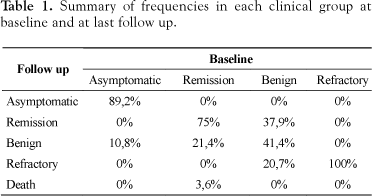OBJECTIVE: To analyze seizure outcome in individuals with familial mesial temporal lobe epilepsy (FMTLE). METHOD: We followed prospectively 64 individuals with FMTLE and 37 asymptomatic individuals belonging to 28 families. RESULTS: Patients with FMTLE had a mean follow up was 93.4 ± 15.8 months. At baseline they were divided in benign (n = 29), remission (n = 28) and refractory (n = 7). At last follow up visit 41.4% patients with benign FMTLE remained classified as benign, 20.7% became refractory and 37.9% were in remission. In the subgroup of FMTLE in remission 21 75% remained without seizures; 21.4% were classified as benign FMTLE, and one died (3.6%) from cause unrelated to epilepsy. All refractory patients remained refractory. From the asymptomatic group, 10.8% became symptomatic (FMTLE). The mean follow up was 76.0 ± 21.2 months. CONCLUSION: Prospective follow up of more than 7 years in patients with FMTLE revealed that it is unlikely to achieve seizure control in those with refractory seizures. Patients with diagnose of more benign forms of FMTLE for more than one year are likely to either remit or remain under well controlled seizures. The majority of patients who had achieved seizure remission remained seizure-free and none became refractory. Asymptomatic individuals had a greater probability to have seizures compared to the general population in a 6 year period of follow up.
Epilepsy; temporal lobe; familial; seizures


